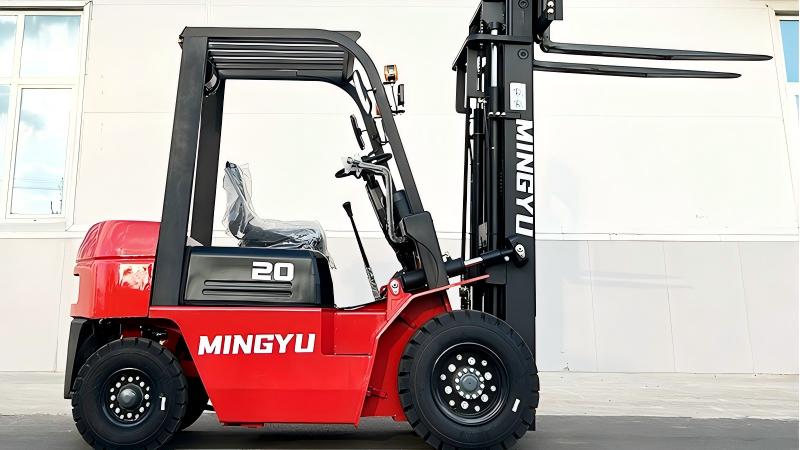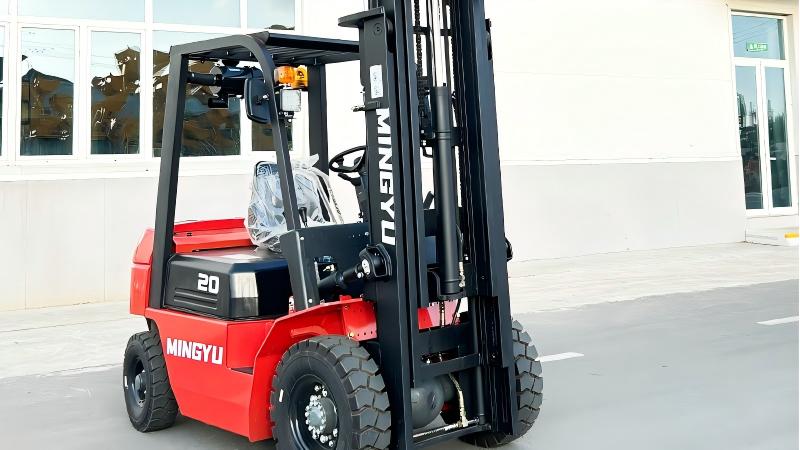The three-point stance rule for forklifts is a fundamental safety principle designed to prevent operators from falling during mounting and dismounting operations. This rule mandates that an operator must maintain three points of contact with the forklift at all times when entering or exiting the vehicle. These three points refer to either two hands and one foot, or two feet and one hand, being in constant contact with the designated steps and handholds. The genesis of this rule lies in the alarming statistics of forklift-related accidents where a significant number of injuries occur not during travel, but during the simple acts of getting on or off the machine. Slips, trips, and falls from a forklift can lead to serious injuries such as fractures, sprains, head trauma, or even fatalities, especially if the operator falls into the path of another moving vehicle or onto a hard concrete surface. Regulatory bodies like the Occupational Safety and Health Administration (OSHA) in the United States, under the general duty clause and specific standards like 1910.178, require employers to provide training that includes safe mounting and dismounting procedures, effectively enforcing the spirit of the three-point stance rule. This practice is not merely a suggestion but a critical procedural step ingrained in all certified forklift training programs globally. Its correct application forms the first and last line of defense for an operator's personal safety during every single work shift, establishing a habitual routine that minimizes risk before the forklift even moves an inch or after it has been completely powered down and parked. The consistent application of this rule is a visible indicator of a robust safety culture within a warehouse or distribution center, demonstrating a commitment to protecting personnel from preventable harm and upholding the highest standards of operational discipline in material handling environments.
Implementing the three-point stance correctly requires a clear understanding of the forklift's design and the specific sequence of movements an operator must follow. Modern forklifts are manufactured with this rule in mind, featuring strategically placed, anti-slip steps and easy-to-grip handholds that are kept clean and in good repair to facilitate safe access. The proper procedure begins with the operator facing the forklift, using one hand to grip the handhold firmly before stepping onto the first step. As the operator ascends, they must ensure that either both feet are securely on the steps with one hand holding on, or one foot is on a step while both hands maintain contact, before transitioning into the seat. The reverse process is followed when dismounting: the operator carefully positions their feet, establishes a firm grip, and then descends, never jumping down or stepping down backwards. Training emphasizes the importance of looking at the steps and handholds during this process, never assuming their location, to avoid missteps. Furthermore, this rule must be followed regardless of the situation, even when the operator is in a hurry, performing a quick task, or the forklift is only moving a short distance. Complacency is a major enemy of this safety rule; experienced operators are just as susceptible to accidents as novices if they become lax in their adherence. Supervisors and safety officers play a crucial role in enforcement through regular observations, audits, and immediate correction of unsafe behaviors. They must also ensure the work environment supports the rule by keeping the operator's compartment free of obstructions, grease, and debris that could compromise grip or footing, thereby making the three-point stance both a practical and an enforceable standard daily practice.
The consequences of ignoring the three-point stance rule are severe and multifaceted, impacting not only the injured operator but also the entire organization. From a human cost perspective, a fall from the height of a forklift cab, which can be several feet off the ground, can result in debilitating injuries that lead to lost time, chronic pain, and long-term disability. For the employer, the ramifications include direct financial losses from workers' compensation claims, increased insurance premiums, potential OSHA fines for safety violations, and costs associated with downtime and hiring replacement staff. Beyond the tangible costs, there is significant reputational damage and a decline in overall workplace morale when a preventable accident occurs. Legally, an accident investigation may find the employer liable if it is determined that adequate training on the three-point stance was not provided or enforced. Therefore, comprehensive forklift operator training programs, such as those compliant with OSHA 1910.178(l), dedicate substantial time to both theoretical instruction and practical, hands-on demonstration of the three-point stance. This training must be site-specific, taking into account the unique models of forklifts used and the particular layout of the facility. Refresher training is also mandatory whenever an operator is observed operating unsafely, is involved in an accident, or is assigned to a different type of truck. This continuous reinforcement ensures that the three-point stance remains a non-negotiable aspect of an operator's muscle memory, deeply embedded in their daily routine to protect their well-being and the company's operational integrity.
In conclusion, the forklift three-point stance rule is a deceptively simple yet profoundly critical safety protocol that serves as a cornerstone of industrial accident prevention. Its universal adoption across industries that utilize forklifts—from manufacturing and construction to logistics and retail—highlights its proven effectiveness in saving lives and reducing injuries. As forklift technology evolves with features like enhanced stability and operator presence sensing, the fundamental human factor of safe mounting and dismounting remains unchanged and irreplaceable by automation. The rule's success hinges on a shared responsibility: manufacturers must design ergonomic and accessible access points, employers must provide relentless training and enforce a culture of safety, and operators must take personal accountability for their actions every time they approach a forklift. Ultimately, the few extra seconds it takes to maintain three points of contact are an invaluable investment in personal safety, far outweighing the devastating cost of a single moment of carelessness. As workplace safety standards continue to advance, the three-point stance will undoubtedly remain a permanent and essential tenet of forklift operation, a timeless practice that underscores the principle that the most important load a forklift operator handles is their own body.
Post time:Nov.19.2025



